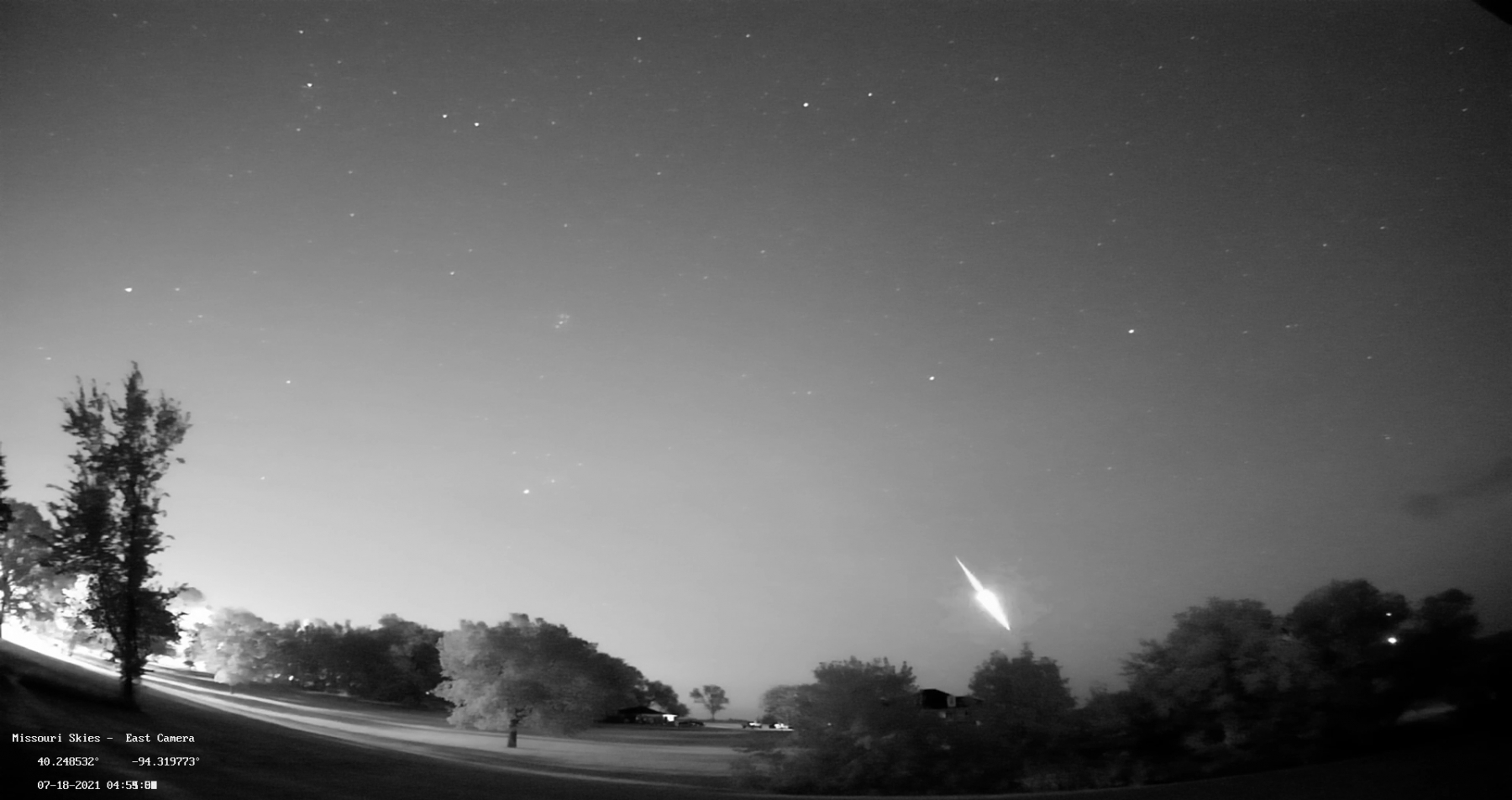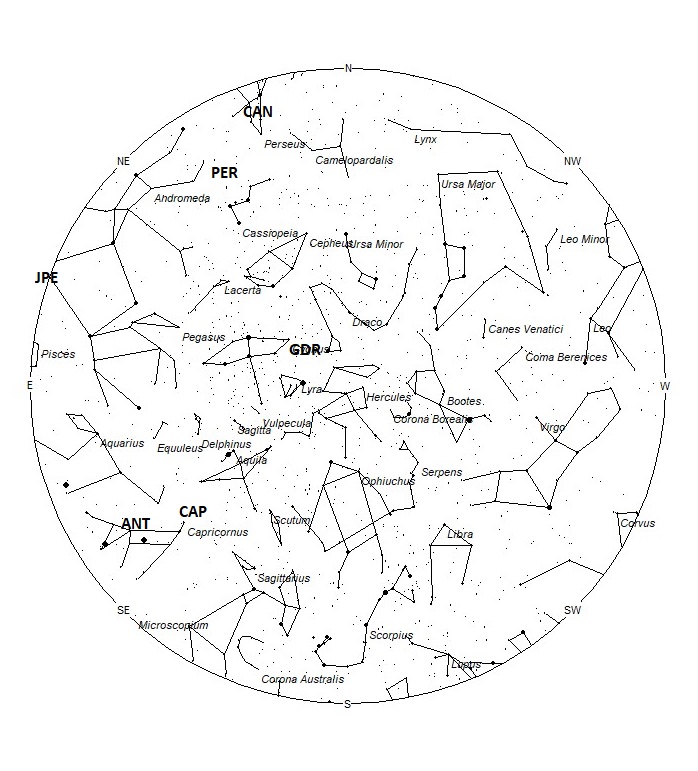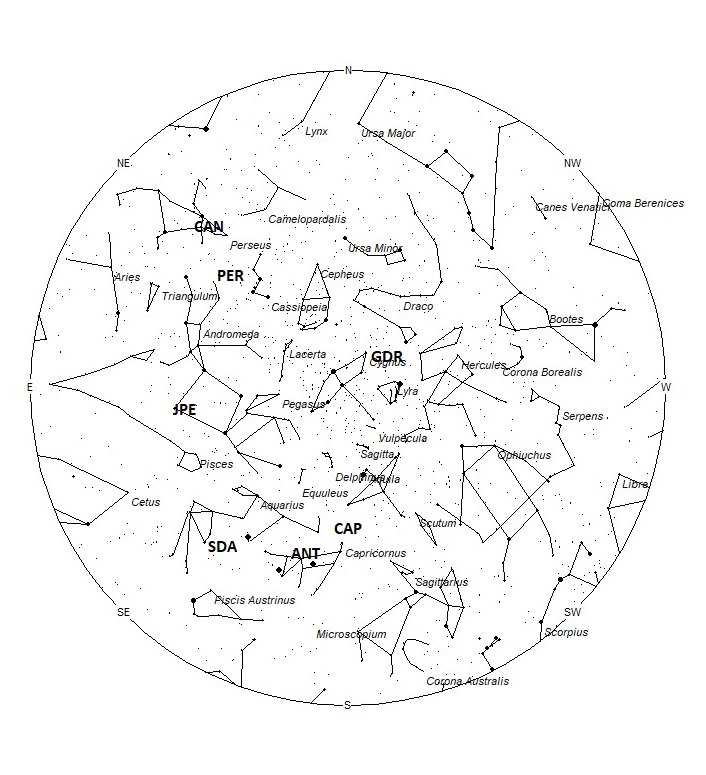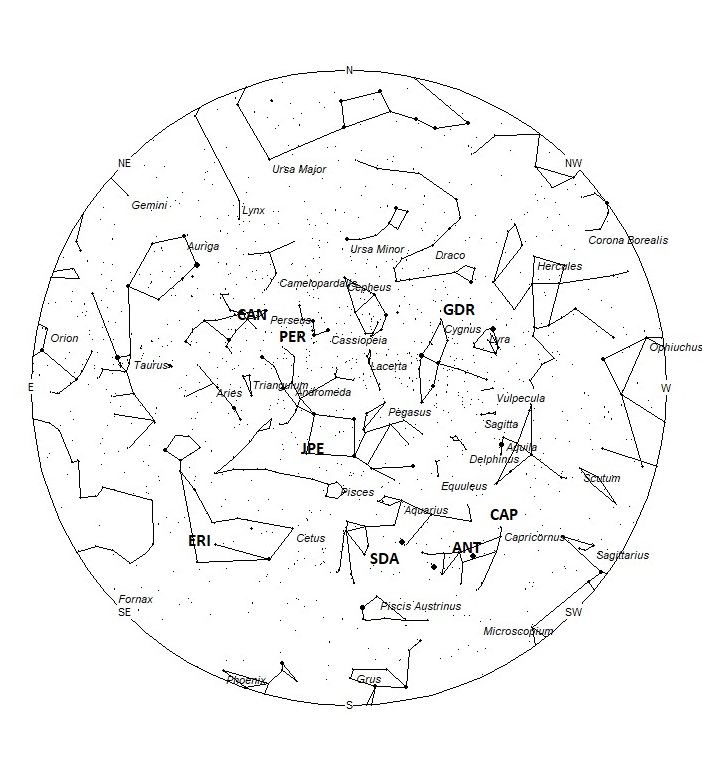
During this period, the moon phase wanes from 100 percent illuminated down to nearly one-half illuminated. This weekend the moon lies opposite the sun and is above the horizon all night long. As the week progresses the waning gibbous moon rises later each night, allowing early evening observing under dark skies later next week. The estimated total hourly meteor rates for evening observers this week is near 2 as seen from mid-northern latitudes (45N) and 2 as seen from tropical southern locations (25S). For morning observers, the estimated total hourly rates should be near 11 as seen from mid-northern latitudes (45N) and 10 as seen from tropical southern locations (25S). Rates are reduced by moonlight during this period. The actual rates will also depend on factors such as personal light and motion perception, local weather conditions, alertness, and experience in watching meteor activity. Note that the hourly rates listed below are estimates as viewed from dark sky sites away from urban light sources. Observers viewing from urban areas will see less activity as only the brighter meteors will be visible from such locations.
The radiant (the area of the sky where meteors appear to shoot from) positions and rates listed below are exact for Saturday night/Sunday morning July 24/25. These positions do not change greatly day to day so the listed coordinates may be used during this entire period. Most star atlases (available at science stores and planetariums) will provide maps with grid lines of the celestial coordinates so that you may find out exactly where these positions are located in the sky. A planisphere or computer planetarium program is also useful in showing the sky at any time of night on any date of the year. Activity from each radiant is best seen when it is positioned highest in the sky, either due north or south along the meridian, depending on your latitude. It must be remembered that meteor activity is rarely seen at the radiant position. Rather they shoot outwards from the radiant, so it is best to center your field of view so that the radiant lies at the edge and not the center. Viewing there will allow you to easily trace the path of each meteor back to the radiant (if it is a shower member) or in another direction if it is sporadic. Meteor activity is not seen from radiants that are located far below the horizon. The positions below are listed in a west to east manner in order of right ascension (celestial longitude). The positions listed first are located further west therefore are accessible earlier in the night while those listed further down the list rise later in the night.
These sources of meteoric activity are expected to be active this week.
Details of each shower will continue next week when observing conditions are more favorable.
| SHOWER | DATE OF MAXIMUM ACTIVITY | CELESTIAL POSITION | ENTRY VELOCITY | CULMINATION | HOURLY RATE | CLASS |
| RA (RA in Deg.) DEC | Km/Sec | Local Daylight Saving Time | North-South | |||
| July gamma Draconids (GDR) | Jul 28 | 18:45 (281) +50 | 28 | 00:00 | <1 – <1 | IV |
| alpha Capricornids (CAP) | Jul 31 | 20:15 (304) -10 | 23 | 01:00 | 1 – 2 | II |
| Anthelion (ANT) | – | 21:00 (315) -17 | 30 | 02:00 | 1 – 2 | II |
| Southern delta Aquariids (SDA) | Jul 30 | 22:28 (337) -17 | 41 | 04:00 | 1 – 3 | I |
| July Pegasids (JPE) | Jul 10 | 00:00 (000) +15 | 63 | 05:00 | <1 – <1 | II |
| Perseids (PER) | Aug 12 | 01:42 (026) +54 | 59 | 07:00 | 2 – <1 | I |
| eta Eridanids (ERI) | Aug 06 | 02:06 (032) -17 | 64 | 08:00 | <1 – <1 | IV |
| c-Andromedids (CAN) | Jul 12 | 03:16 (049) +52 | 57 | 09:00 | <1 – <1 | IV |
 American Meteor Society
American Meteor Society



I heard a loud boom Sunday night after 9pm and it shook my house. I was inside at the time so I didn’t see it.
What do you guys know about the meteorite that disappeared over north Texas. July 25th 9pm I believe.
Lee and All,
Check out: https://fireball.amsmeteors.org/members/imo_view/event/2021/4002
saw a lg. fireball 7-26 @ bout 10 pm pdt streaking app. NE-SW passing overhead western Indio Hills @Fan Hill R-O-W 1 mile:N of Dillon/1000 Palns Cyn interstection – probably Perseid
We are planning on heading out on August 11th to watch the perseids. The only issue is, we are in Missoula and the sky has been smokey and hazy. Do you have any recommendations for where to go?
Is it just me, or nobody saw the the meteor that hit Norway coming?
While it created a bright flash in the sky, the Norway meteor was only a meter or so in size, which is too small to pick up while still out in space with our current technology. The smallest objects we can normally pick up are 10 meters in size and larger.
I saw this early this morning. Any thoughts?
I saw a blue/green fireball, shooting star above the San Fernando valley, in Los Angeles CA. Canoga Park to be exact.
Saw a green blue fireball July 28 around 1 am in San Gabriel Valley El Monte, Ca. Shined bright for a second or two then disappeared.
I saw a beautiful golden meteor or fireball over Stockton, Mo on Friday July 30th around 10:45pm. It went east to west. It was so close I could hardly believe my eyes. It was outstanding.